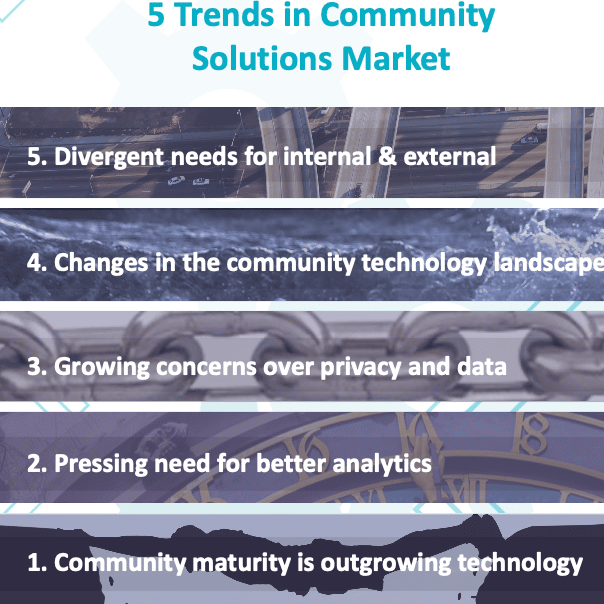
These 5 trends in Online Community Technology Solutions represent our observations and interactions with hundreds on online community management professionals and solutions providers.
There has never been a greater diversity of tools offered, and the ongoing change in the online community technology marketplace points to continued diversification.
Do these 5 trends resonate with you?
#1 Community Maturity Is Outgrowing Technology
15 years ago community technology was pulling individuals and organizations into a new way of communicating, building relationships, and engaging. The technology excited us and showed us how we could unlock this amazing potential.
Fast forward to today – many community teams fight with technology daily to get it to meet their needs. That includes expensive additions and changes. It also includes spending all of their time on the technology instead of with the people that matter. It limits what they can do.
It is incredibly frustrating AND it represents a huge opportunity. We believe this opportunity centers around governance and data because our clients are looking to build ecosystems of communities that will transform both how they engage with their employees and markets AND their business models.
PowerPoint Presentation
#2 Pressing Need For Better Analytics
We are pretty good at counting. Number of members, number of log-ins. Number of views. Number of threads. That’s great – we can tell there’s a heartbeat and whether our communities are getting exercise.
But what about our overall health? We struggle to understand in that morass of data, what matters. Are we gaining muscle? We can rarely see how that impacts the cost or value associated with it – or how it happened so we can encourage more of it in the future.
There has been a ton of research in behavioral economics and psychology over the last decade as well as a lot of research into communities and social networks. Most of that has not yet shown up in analytics and dashboards. You could argue that because this is such a big gap, sales, renewals, and the very viability of some platform providers have been put at risk.
#3 Growing Concerns Over Privacy And Data
We can thank the Cambridge Analytica scandal for helping educate stakeholders about the value and power of engagement data. This has also exposed concerns over the experience of our customers and employees – and opened a conversation about whether organizations can provide a better experience.
It brings up ethical dilemmas – Information and truth can be manipulated – what responsibility do we have and how does this impact trust?
This is driving the need for more controls over data and how it is used and displayed.
#4 Changes In The Technology Landscape
There is a massive proliferation of tools and channels – yesterday’s gchat is today’s Slack. Big vendors like Microsoft and Salesforce are making inroads, while older vendors are merging, changing ownership and leadership, and adapting.
This market activity is creating a lot of churn, prompting a lot of migration, and consuming a lot of attention for community management teams – but also prompting reflection with regard to strategy.
#5 Divergent Paths For Internal and External
Communities are no longer isolated and are much more integrated into the work of the organization – that is great news! But engagement patterns internally and externally are quite different, which requires integration with different communication and content systems and different functional groups.
Community ecosystems are becoming the information map of organizations, helping people navigate to where they need to go.
